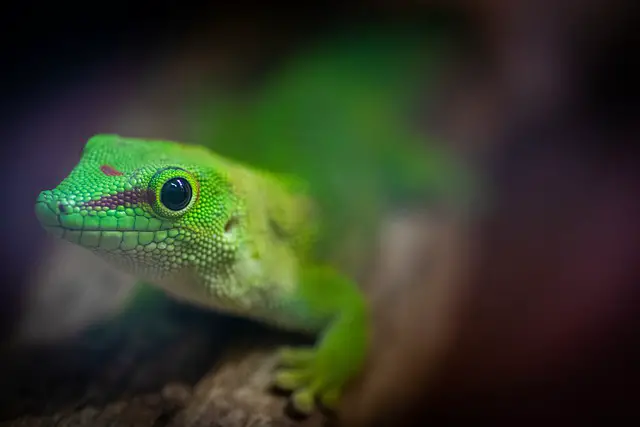Geckos are becoming a popular choice for pet owners. Generally speaking, reptile owners amass over 3% of the U.S population. With increased gecko sales, some pet owners may want to improve their reptile collection and add a co-habitat.
While some species may cooperate reasonably, others may not. As a giant day gecko owner, you may wonder, “Can you co-hab giant day geckos?” In some cases, if your male giant day gecko has matured, you can add a female.
If you already have a female, then you can add another female. The pairing you’ll want to avoid is two males. Now, what about mixing species? While possible, you may not want to co-hab a giant day gecko with other species if you’re a new reptile owner.
Stick around to learn more about giant day geckos and their co-hab capabilities.
Can Giant Day Geckos Live Together?
Giant day geckos can live together harmoniously as breeding pairs. You may also keep a single male with a group of female giant day geckos. If you house male geckos together, then fights are bound to happen. Males can squabble until the superior gecko injures or kills its weaker opponent.
In other instances, a female and male giant day gecko may also break into fights. In which case, you’ll want to separate them immediately. In contrast, successful male and female pairing should not be separated. Otherwise, both may choose not to mate with other geckos.
If you’re not trying to breed geckos, then you may want to avoid co-habiting your giant day gecko in the first place. Instead, you can own a solitary male or a small group of female geckos.
Can Giant Day Geckos Co-Hab with Other Species?
Giant day geckos tend to be picky with their cage mates. So much so that they might end up eating them. If you’re adding a dart or red-eyed arboreal frog, it’s practically fair game, especially if you forgot to feed the gecko.
Day geckos may also consume species such as anoles since they’re relatively minor. They occupy the same space because they’re similarly active during the day and like to crawl on surrounding branches.
You’ll want to look for a cage mate that won’t be interacting much with your giant day gecko. Since the gecko species is diurnal and arboreal, you’ll want to look for nocturnal and terrestrial species.
For this reason, frogs may be the likely vivarium partner for giant day geckos. Now, you also wouldn’t want to get any frog. Some frogs, like the African bullfrog, can eat geckos. Others may also be poisonous, so if your gecko decides to eat one, it’ll join the frog’s fate.
Another co-habitant worth looking at is chelonians, turtles, and tortoises. They can withstand similar temperatures, and neither will be able to consume one another. Additionally, chelonians don’t generally climb so that they won’t get in your giant day gecko’s way.
What to Consider Before Adding Cagemates for Your Giant Day Gecko
Whether you’re incorporating other giant day geckos or other species, there are some factors you’ll need to consider first. Here are some of them below.
Cage Size
Imagine living in a studio apartment with two other flatmates. In a few days, you’ll probably get on each other’s nerves from being cooped up in a small space. That’s how your giant day gecko may feel if you add a companion in the same cage.
For this reason, you’ll need to purchase a larger vertical cage to accommodate the new number of inhabitants. Each reptile or amphibian needs basking, feeding, hiding, exercising, and sleeping.
Things can get messy if you don’t have ample space since giant day geckos, like some reptiles, are territorial creatures. They can fight those bringing in their way, which could lead to severe injuries or, in some cases, death.
Climate and Environment
Giant day geckos need to live in certain temperatures to thrive. With a larger cage, you’ll want to install more heat sources and thermometers to accommodate the new guests. The gecko species needs a basking temperature of around 75 to 80 degrees F with humidity ranging between 50% to 70%.
Meanwhile, other reptiles and amphibians have similar temperature and humidity needs. For example, turtles require temperatures between 80 to 85 degrees F and a humidity of about 65%. Although, tortoises may need a hotter basking climate reaching up to 90 degrees F.
Apart from that, with more residents, you’ll want more plants, branches, and hiding spots. If you’re getting more arboreal species, then get more climbing spaces for perching and basking.
Health Considerations
Before placing the reptiles in the cage, you’ll want to quarantine them initially. That way, you’ll avoid any potential spread of diseases. A 60-day quarantine with a fecal parasite examination is highly recommended.
In addition, moving your giant day gecko to a larger tank may result in stress from new and unfamiliar surroundings. The pressure may then lead to diseases like the development of gastrointestinal parasites.
Do Giant Day Geckos Get Lonely
The good news is that no matter how long you leave your giant day gecko alone, it won’t get lonely. The cold-blooded reptile prefers being housed alone instead of sharing its living space and food. Nonetheless, that doesn’t mean it’s emotionless.
.
To Conclude
Can you co-Hab giant day geckos? In short, yes, you can. Big day geckos can live with their kind and mix with other species such as turtles. If you’re adding another giant day gecko to the tank, make sure the pairing isn’t all male. Otherwise, it could result in clashing.
That being so, an even female to male ratio or one male with a group of females should create a more harmonious environment. Apart from that, if you add a new species, ensure they have compatible vivarium needs such as temperature and humidity settings.




